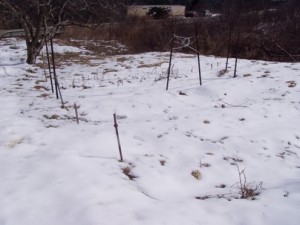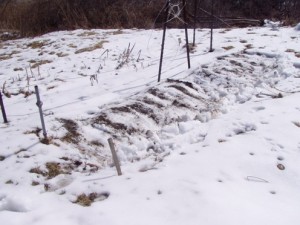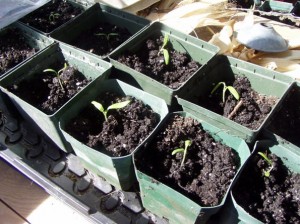 Anyone who knows me will tell you that I am one impatient gardener. Last year, we got lucky and by this time, it had been in the 60s for several weeks. No such luck this year. The photo at the top was taken about a week ago. faced with a garden covered in snow and wanting to get things started, I know only one way to jumpstart the soil- warming process.
Anyone who knows me will tell you that I am one impatient gardener. Last year, we got lucky and by this time, it had been in the 60s for several weeks. No such luck this year. The photo at the top was taken about a week ago. faced with a garden covered in snow and wanting to get things started, I know only one way to jumpstart the soil- warming process.
Shoveling.
Yes, I literally took out my show shovel and scraped off as much of the snow off one of the garden beds as I could. And it looked like this:  The ground was frozen solid so there was no way to get anymore of that off without removing actual soil from the bed. But the thing is this: Once you’ve taken the top layer of the snow off, if there is any sun or warmth at all, the rest will melt off. and then you have dark soil. And if there is any sun at all, that will start to warm up.
The ground was frozen solid so there was no way to get anymore of that off without removing actual soil from the bed. But the thing is this: Once you’ve taken the top layer of the snow off, if there is any sun or warmth at all, the rest will melt off. and then you have dark soil. And if there is any sun at all, that will start to warm up.
I’m not kidding you. Literally within a couple of days, not only was everything melted off that bed, with the other beds to follow, but the soil in that particular bed was up to 39 degrees F. From ‘frozen solid’ to 39 degrees. And that is without any help from glass or plastic (which I put out this weekend since we are slated to have a sunny week this week. I’m pushing hard to get that bed up to 50 degrees so that I can put in seeds for lettuce, cabbage, broccoli, chard, beets and other cold-hardy crops. I’m just itching to get out there but just can’t until that soil warms up.
Other activities which keep me from going bonkers about not being able to get out and put my hands in the soil are starting seeds. About two weeks ago, I started various tomatoes (including seeds from a paste tomato that I saved in 2008 (that is not a typo, folks – tomato seeds under the right conditions (in this case, inside waxed paper inside a ziplock(tm) bag in the fridge door) will stay potent for a long time. And I think every single one of those seeds came up. I was amazed.
Now, I’ve tried all sorts of DIY methods on seed starting, including a wonderful screened table that the DH built for me in the basement where we clipped infrared lights that are used for brooding chicks underneath the screens, but in the end, the trick is:
a) You need a gentle source of heat underneath the soil and
b) You need a humid atmosphere
Once they are germinated, then you need sunlight. They took off so quickly that by the time I got time to transplant them this weekend, they had gotten too big, so I pulled together some 4″ pots and planted the seedlings up to their leaves in soil. Another thing I did, which I also advocate is that I dragged the potting mix out onto the patio into the sun, filled the pots out there and left them there in the sun for most of the day to bring the soil temperature in the bots up to at least 50. That bag of potting mix had been in the garage and it was frankly about 35 degrees. If I’d transplanted into that, I’d have killed or stunted the tomatoes for sure. As it is, they are very happy campers now. The peppers are not as far along, which is standard, though I’m not sure why peppers should take longer to germinate and take off than tomatoes do, but I have never had an experience where they have not been slow.
The peppers are not as far along, which is standard, though I’m not sure why peppers should take longer to germinate and take off than tomatoes do, but I have never had an experience where they have not been slow.
So, at the moment, I have a couple of garden beds which are now under plastic and hope the sunny days this week will bring them up at least into the 40s. It usually takes a couple of weeks of solid warm weather and sun to raise the soil under glass or plastic into a temperature range where I can feel reasonably secure about putting even cold-weather crop seeds into it. If I had them as seedlings, it would not be as risky, but they are easy enough to plant into the soil if it’s in the 50-degree range.
What are you planting this year? My new vegetable this year is parsnips. I had a wonderful dish of parsnip puree during the winter and I’m willing to give them a shot.
